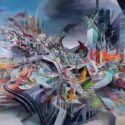Last Saturday, on November 2, Danish KIRK Gallery opened a new large solo show with US artist Oliver Vernon, whose work within modern abstraction has made him one of the most interesting figures in the contemporary art scene today.
Brushing Away The Veil consists on a series of works – some begun long time ago – where Vernon abandons his characteristic collage process all together and experiments with acrylics instead of paper in an attempt to retake painting in what he calls “a building desire to return to direct painting”:
“This body of work was a return to direct painting after years of using collage as a means to deliver paint to surface.Priorly I was painting on large rolls of paper as a starting point, to enable a sense of freedom of loose paint handling without needing to know how it would fit into the eventual compositions. The paper was then ripped and torn into fragments which were then recomposed onto panel. This allowed me to find new types of juxtapositions of color and form outside of my habitual tendencies, which fulfilled a need to plow into uncharted visual territory. I adhered to this method so as to develop a consistent new language. As satisfying as it was, there was a building desire to return to direct painting, and then finally for this show I abandoned the collage process altogether.”
Most of the works in this exhibition were begun separately years ago, and then gathered together by the artist earlier this year into what was to become this body of work. In the early months of production, Vernon underwent the usual stages of experimentation without an imperative of cohesion. Each piece had its own direction, but as he explains, as the process continued, there was a point at which a common thread began to weave its way through.
“It was like descending down a staircase into the depths of my own art history. Techniques that I had left in the past began to flow back into the present. It was as if I unlocked an inner vault, allowing past and present to mingle.”
Forgotten history brought to the surface
As explained by the artist, a large part of this had to do simply with brush size where larger brushes has been used, removing the emphasis from small detail. In Brushing Away The Veil, Vernon goes back to using small brushes giving room to a series of pieces characterised by what he calls an extensive treatments of micro-scaled interconnectivity.
Another aspect present in the new series is the excavation of buried paint layers through sanding. The canvases were persistently painted over time, becoming gold mines in terms of colour and texture, where the sanding tools became painting tools. In relation to this Vernon adds:“The textures of abrasion engaged in a dialogue with the rest of the brush-applied paint. These sanded passages felt like mist, smoke, foliage, atmosphere. I began to see figures emerge, populating the abstract environments, contributing to the worlds-within-worlds view.“ In many ways, this is how Vernon slowly brushes the veils away, revealing the archeology of colour and texture in his work.
Brushing Away The Veil will be on view until November 23 at the gallery located on Danmarksgade 8, 9000 Aalborg, Denmark.
About the artist
 Oliver Vernon was born in New York in 1972, and lives and works in Grass Valley, California, today. He received his BFA from Parsons School of Design in 1995.
Oliver Vernon was born in New York in 1972, and lives and works in Grass Valley, California, today. He received his BFA from Parsons School of Design in 1995.
Visually, Oliver Vernon’s paintings draw upon an incredibly varied pool of influences, from abstract expressionism, to post pop surrealism and the polished finish of figurative realism. Formally, his work is about the deconstruction, and hence the necessary reconstruction of visual space. From this central dichotomy stems many others: logic/illogic, physical/metaphysical, imprisonment/liberation.
His paintings come to us, perhaps, as detailed snapshots of the few primordial milliseconds when the blueprint of the universe was being sculpted from the final throes of chaos. In this sense, anything goes. Each painting has its own set of rules, or rather the rules are being bent, broken and ultimately formed within each painting. Color, form, energy, architecture, good, evil, flesh and machine are lurking, never as physical entities, but as transient archetypes searching out their final places within the framework of the cosmos. Apart from this macro view, Oliver’s work can be seen at the micro level as well. We can view his paintings as representations of how the mind is formed from a foundation of thought, reason, and aesthetics, and how these entities are simultaneously at odds and interconnected.
www.oliververnon.com
www.kirk-gallery.com
Author: Fran
Founder and editor of Urbanite. Street Art lover who after the finishing her MA thesis on the Mexican and Norwegian muralist movement in the 1920-50s, developed a fascination for street art and graffiti that eventually led to collaborations with different art blogs, including the creation of this one.







You must be logged in to post a comment.